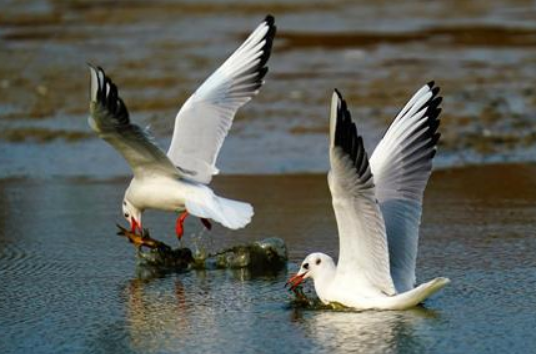摘 要
风景园林规划是解决人与自然之间相互关系的问题的学科,而生态规划是风景园林规划中的重要部分,包括对人居环境的修复、湿地生态修复和生物多样性保护等。农业扩张和城市化导致我国湿地及相关动植物群落衰减,而迁徙水鸟作为实地生态系统的重要组成部分,可以用来评估当地的生态环境,但其数量也在显着减少。为了研究生态补偿对迁徙水鸟保护作用,该实验利用生态补偿计划的资金,在广西北仑河口自然保护区的五个村庄租用水产养殖虾塘,并在冬季和春季虾养殖的冬歇期降低虾塘水深,通过记录不同时间下虾塘中鸟类的物种丰富度和鸟类觅食频率,以及虾塘水质情况,探究人工湿地对鸟类的影响,并且还对比了人工湿地与自然湿地的鸟类丰度和丰富度。
实验结果表明,抽水虾塘中迁徙水鸟的物种丰富度约为非抽水虾塘的两倍,物种丰度约为非抽水虾塘的十倍,且迁徙水鸟中鸻鹬类(Scolopacidae)啄食频率比其他迁徙水鸟频率要高,不同的水产养殖虾塘的水质对不同鸟类有着不同的影响。另外,自然湿地迁徙鸟类的个体数明显高于人工湿地(自然湿地:1287.82±2503.35,人工湿地:185.22±348.92);抽水与非抽水人工养殖虾塘深度差异显着, 抽水与非抽水的水产养殖虾塘p H指数差异不显着,因其溶解氧、总溶解固体、电导率、盐度这些水质参数都在标准范围内。受环境因素的影响,迁徙水鸟的物种丰富度发生显着性变化。实验结果显示,红嘴鸥(Larus ridibundus)、灰鸻(Pluvialis squatarola)、黑水鸡(Gallinula chloropus)物种的数量与水深(cm)呈正相关,金眶鸻(Charadrius dubius)、黑翅长脚(Himantopushimantopus)物种的数量,与溶解氧(mg/L)呈正相关,泽鹬(Tringa stagnatilis)、黑腹滨鹬(Calidris alpina)、环颈鸻(Charadrius alexandrinus)物种数量与电导度(ms)和p H指数呈正相关。研究结果表明,通过生态补偿项目对虾塘进行简单的降水工程干预措施,有助于增加迁徙水鸟对人工栖息地的利用,特别是鸟类的越冬迁徙。虽然人工湿地能够为迁徙水鸟提供暂时的栖息地,但总体来说人工湿地无法替代自然湿地。所以在风景园林规划中,对自然湿地进行有效保护以及如何修复人工湿地尤为重要。
关键词 : 生态规划;迁徙水鸟多样性;虾塘冬歇期;生态补偿;人工湿地 。
ABSTRACT
Landscape garden planning is address issues that involving the interrelationship betweenhuman and ecology. Ecological restoration is key part of landscape in planning, including therestoration of human environment, wetland ecological restoration and biodiversityconservation. China agricultural expansion and urbanization result in the decay of wetlandsand associated animals and plants. Migratory shorebirds, an important part of the ecosystemin the field where were rapidly declining in numbers. Birds have the ability that to assess thelocal ecological environment. To study the conservation effects of ecological compensationon migratory shorebirds, we used the funds from the Eco-compensation Program to rentagriculture ponds at five villages in Guangxi Beilun Estuary Nature Reserve. In winter andspring the lowered depth of water of ponds where were not in use. We recorded theabundance and richness of birds in the ponds and the frequency of birds foraging, as well asthe effects of pond water quality on birds over time. We also compared artificial wetlandswith natural richness and abundance.

We results show that species richness of migratory shorebirds in pumped ponds was abouttwice as high as in non-pumped ponds, the species abundance was about 10 times higher thanthat in non-pumped ponds and the pecking frequency of Plovers (Scolopacidae) amongmigratory shorebirds was higher than the frequency of other migratory shorebirds. At thesame time, water quality in aquaculture ponds showed different effects on different birdspecies. Besides, the abundance and density of migratory birds were significantly higher innatural wetlands than in artificial wetlands (natural wetlands: 1287.82±2503.35, artificialwetlands: 185.22±348.92). Pumped than non-pumped depth was significant, pumped thannon-pumped p H don't significant benefits dissolved oxygen, total dissolved solids,conductivity, salinity, and each all water quality was within the standard range. Migratoryshorebird species richness was influenced by environmental factors and significant changeswere found. According to the results, response variables were used as vectors, speciesvariables, and it was found that the number of species such as Black-headed Gull (Larusridibundus), Grey Plover (Pluvialis squatarola) and Common Moorhen (Gallinula chloropus)were positively correlated with water depth (cm), species such as Little Ringed plover(Charadrius dubius) and Black-winged Stilt (Himantopus himantopus), were positivelycorrelated with dissolved oxygen (mg/L), and Marsh Sandpiper (Tringa stagnatilis), Dunlin(Calidris alpine) and Kentish Plover (Charadrius alexandrines) were positively correlatedwith electrical conductivity (ms) and hydrogen ion concentration index (p H). The results ofthe study suggest that the simple interventions about the dewatering engineering to thebreeding ponds, from the aspect of ecological compensation programs, that increasing the useof artificial habitat for migrating shorebirds, especially for overwintering migration. However,artificial wetlands can provide temporary habitat for migrating shorebirds and overallartificial habitat cannot be a substitute for natural habitat. The conservation of natural wetlands and the restoration of artificial wetlands are particularly important in all landscapegarden planning.
KEY WORDS : Ecological planning; Migratory shorebird biodiversity; Shrimp ponds winterrest time; Ecological compensation; Artificial wetlands。
第一章 绪论
1.1、研究背景 。
1.1.1、湿地影响生态规划背景 。
自从上世纪麦克哈格的《设计结合自然》将生态学纳入风景园林规划中后,这标志着风景园林生态规划的到来。党的十九大以来,中央从生态文明建设的整体视野提出“山、水、林、田、湖、草”的治理理念,并明确指出应“坚持人与自然和谐共生”。
同理在风景园林规划中不仅要关注规划问题又要关注生态问题。自此,我国风景园林规划的指导思想从“环境论”转化为“生态论”。当前,风景园林生态规划既要解决人类和居住环境的关系,又要考虑规划方案中人与生态的关系。而生物多样性保护是生态环境中最重要的环节之一,自然生态也成为风景园林规划设计方案中对生态施行评估的重要手段。湿地是生态系统重要部分,也是动物的重要栖息地之一,在湿地栖息的动物包括鸟类、昆虫、两栖和爬行类等,都是自然生态中的重要成员。湿地作为重要的景观,是风景园林规划中不可或缺的一部分,小到人居环境,大到城市绿地规划,湿地的人文和生态价值十分重要。湿地具有调节气候、防止城市热岛效应和保存生物多样性的作用。
然而,包括同属在风景园林规划范畴的“其他绿地”区域在内,全球的自然湿地面积都在急剧的减少,这导致了绿地规划的“难题”,造成了一定的经济损失,更重要的,这会加剧城市中风景园林规划的生态评估压力。因此,生态多样性成为风景园林规划重要课题。
当今,人类正处于全球化的加速时代。随着全球城市化进程的加快,一方面,土地利用方式的变化和城市灰色基础设施的建设侵占了大量的自然栖息地,如沿海湿地。另一方面,国家基于对粮食生产底线的保障和对生态系统保护之间的权衡,加快了自然湿地丧失的趋势[4-8]。尽管世界各国在生态恢复方面投入了大量资金,但自然湿地的减少仍在加剧[1-3]。据全球人口统计数据显示,全球人口总数在过去50年里翻了一番,其中有7.92亿人正遭受饥饿和营养不良,占全球人口的10.9%。近年来,这个问题不但没有得到缓解,反而加剧了自然湿地和农业生产之间的冲突。自然湿地的减少,导致了世界范围内依赖湿地生存的迁徙水鸟的数量骤减。
全球各国联合出台了《生物多样性公约》并要求对湿地进行更大规模的管理和保护。
但全球湿地总面积仍在不断较少,湿地的丧失成为了迁徙水鸟多样性下降的最主要原因 [9-11],显然,贯彻执行《生物多样性公约》的道路任然任重而道远,它的出台并没有起到相应的作用。自然湿地的减少使得人类急需寻找新的湿地和制定新的修复湿地模式,以此来缓解和抑制迁徙水鸟数量下降的速度。其次,全球20-50%的湿地保护区并没有对迁徙水鸟种群进行有效的保护,这也会加剧迁徙水鸟种群下降的风险。除此之外,世界各国的经济实力也是建立野生动物保护的关键,在发展中国家,只有10%的迁徙鸟类分布范围被保护区覆盖和保护[12-15]。
东亚-澳大利亚鸟类迁徙区域是全球范围内被破坏最严重的鸟类迁徙区[16-17]。该迁徙区的迁徙水鸟数量在以每年5-9%的速度减少。而中国位于东亚-澳大利亚迁徙区域内,并且作为世界性大国,中国的湿地修复和生物多样性保护工作备受期待,沿海湿地的修复进展成为全球关注的焦点[3-6],因此,园林规划该如何有效保护依赖湿地的迁徙水鸟,这一问题变得非常重要和棘手[18-21]。
鸟类对生态环境特别敏感,它们是最常见的野生动物,也是一个很好的生态指标组[22-24]。不同鸟类物种对栖息地需求不同,鸟类还会对环境变化做出相应的响应。冬季迁徙期间,鸟类会选择更有利于它们生存的自然环境栖息和觅食。受食物的丰富度和食物分布情况的影响,鸟类对栖息地的选择十分灵活[51],农业用地扩张导致大量人工湿地的出现,所以人工湿地也成为迁徙鸟类重要的栖息地之一。鸟类栖息地也成为生态规划的重点关注区域。
【由于本篇文章为硕士论文,如需全文请点击底部下载全文链接】
1.1.2 修复湿地政策背景.
1.1.3 人工湿地发展现状.
1.2人工湿地的生态旅游(观鸟旅游)价值
1.3鸟类对生态评估的意义
1.4湿地分类.
l.5 研究目的
1.6研究意义
第二章 区域与实验方法.
2.1研究区域
2.2研究内容
2.3 研究创新点与难点.
2.3.1研究创新点
2.3.2研究难点
2.5技术路线.
第三章 湿地修复案例研
3.1国外人工湿地案例.
3.1.1塞浦路斯.
3.1.2日本
3.2国内人工湿地案例
3.2.1.上海
3.2.1江.苏
3.3本章小结
第四章 干预后实验样地各生态指标结
4.1迁徙水鸟在规划后人工湿地栖息情况
4.1.1迁徙鸟类物种丰富度与丰度
4.1.2环境因素影响鸟类丰度和丰富度.
4.1.3环境因素影响迁徙水鸟啄食率
4.2人工湿地中水质指标参数结果.
4.2.1 pH指数.
4.2.2电导率、溶解性固体总量和盐度
4.2.3抽水/非抽虾塘样地参数对比.
4.2.4虾塘中水质指标和鸟类冗余分析结果
4.3生态规划带动相关产业
4.4本章小结.
第五章 与展望.
5.1结论.
5.1.1生态规划中环境的影响
5.1.2生态规划区中水质的影响.
5.1.3规划虾塘有利于鸟类多样性.
5.2展望
5.2.1生态规划对城市绿地启发.
5.2.2生态规划对生态系统影响
5.2.3生态规划对旅游意义
5.3、主要创新点。
本实验主要创新点为:
(1)租用虾塘,给迁徙水鸟提供临时栖息地。因为,虾塘养殖是广西特色产业。
(2)调查环境因素和水质因素对迁徙水鸟丰富度和丰度,以及食物源的影响,明确水鸟对生态规划区的生物响应。
(3)对比人工湿地和自然湿地对鸟类的影响,明确主要保护对象和辅助对象,明确保护目的。
参考文献.
[1]马志军,栖息地保护对鸟类保护的重要性[J].生物学通报,2017, 52(11).
[2] Amano T, Szekely T, Sande B, et al. Successful conservati on of global waterbirdpopu lations depends on effective governance [J]. Nature, 201 8, 553(7687): 199-202.
[3] Anderson M G, Alisauskas R T, Batt B D J, et al. The migratory bird treaty and a centuryof waterfowl conservation [J]. The Journal of Wildlife Management, 2018, 82(2):247-59.
[4] Bekkers R, Wiepking P. A Literature Review of Empirical Studies of Philanthropy [J].Nonprofit and Voluntary Sector Quarterly, 20 l0, 40(5): 924-73.
[5] Brandolin P G, Blendinger P G. Effect of habitat and land scape structure on waterbirdabundance in wet lands of central Argentina [J]. Wetlands Ecology and Management,2015, 24(1): 93-105.
[6] Schleicher J, Peres C A Leader-Williams N. Conservation p er formance of tropi calprotected areas: How important is management? [J]. Conservation Letters, 2019,12(5);:e 12650.
[7] Sebastiano M, Eens M, Pineau K, et al. Food supplementation protects Magni ficentfni; gatebird chicks against a fatal viral disease [J]. C onservation Letters, 2019, 12(3):el12630.
[8] Venter O, Fuller R A, Segan D B, et al. Targeting global protected area expansion forimperiled bi odiversity [J]. PLoS Biol, 2014, 12(6): el001891.
[9] Wu R, Possingham H P, YU G, et al. Strengthening China's national bi odiversity strategyto attain an ecological civili zation [J]. Conservation Letters, 2019, 12(5): 12660
[10] Dotta G, Phalan B, Silva T W, et al. Assessi ng strategi es to rec onci le agriculture and birdconservation in the temperate grassl ands of S outh America [J]. C onserv Biol, 2016,30(3): 618-27.
[11] Bai M-L, Chin W-C, Lai YC, et al. Aquaculture Ponds as Important High-Tide Habitatsfor Waterbi rds Along the West Coast of Taiwan [J]. Ornithological Science, 2018, 17(1):55-67.
[12]蒋光伟,周放,余辰星,等.广西北部湾沿海地区水鸟多样性及季节变动[J].广西科学,2012, 19(2):174-179.
[13] 程翊欣,王军燕,何鑫,等.中国内地观鸟现状与发展[J].华东师范大学学报:自然科学版,2013(2):63-74.
[14]周放,房慧伶,张红星,等. (2002). 广西沿海红树林区的水鸟、基因组学 与应用生物学, 21(3), 145-150.
[15]余辰星,杨岗,陆舟,等. (2014). 迁徙季节水鸟对滨海不同类型湿地的利用一一以广西山口红树林自然保护区为例.海洋 与湖沼,45(3), 513-521.
[16] Jackson M V, CarrascoL R, Choi C Y, et al. Multiple habitat use by dec lining migratorybirds necessi tates joined -up conservation [J]. Ecol Evol, 2019, 9(5): 2505-25 15.
[17] Jiang T-T, Pan J-E, Pu X-M, et al. Current status of coastal wetlands in ChinaDegradati on, restoration, and future management [J]. Estuarine, Coastal and ShelfScience, 2015, 164: 265-275.
[18] Smith R J, Bennun L, Brooks T M, et al. Synergies between the key bi odiversity area and systematic conservation planning approaches [J]. C onservation Letters, 2018, e12625.
第二章关于滨水生态规划设计理论的研究2.1滨水景观的概念及设计原则滨水景观,是一种独特的线状景观,是形成城市印象的主要构成元素之一,极具景观美学价值。一个城市滨水景观,可以提升城市的形象、扩展城市休闲空间,发展旅游等良好的作用。(1)尊重...